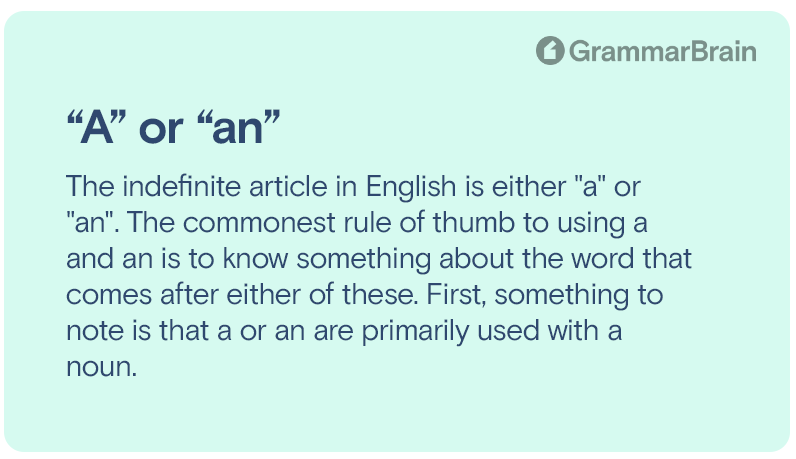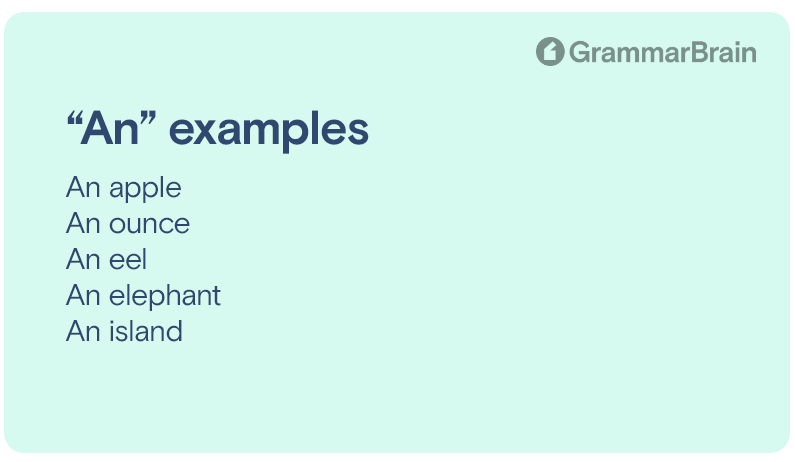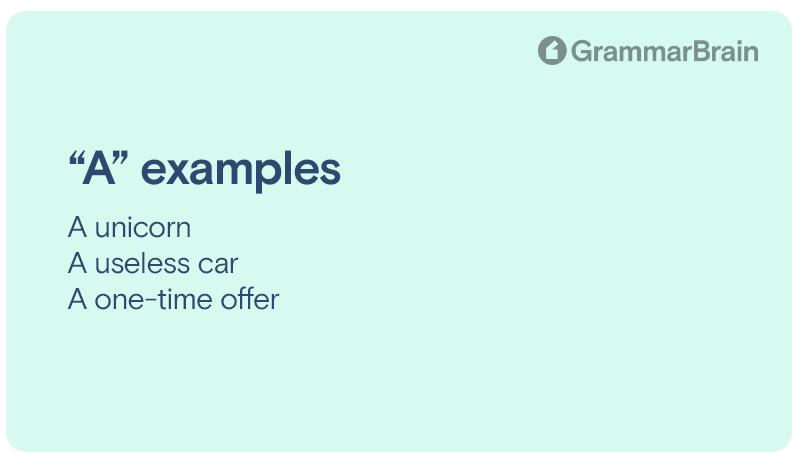Is it “a” or “an?” How do I know when to use “a” or “an?” English can be a confusing and somewhat complex language. It can be an eternal struggle to understand the nuances of English grammar, and this is where the perennial issue of a or an enters the picture. The first thing to note is that these words are indefinite articles in English. The word “indefinite” gives an idea of the purpose articles serve.
What is the indefinite article?
The indefinite article in English is either “a” or “an”. The commonest rule of thumb to using a and an is to know something about the word that comes after either of these. First, something to note is that a or an are primarily used with a noun. That means either indefinite article comes before a noun. Here are some examples of a and an with nouns:
- A dog
- An orange
- A house
- An antelope
- An envelope
- A meal
Why are these words called indefinite articles? A or an is used to refer to a thing or a person (a noun) which is not specific or identifiable (indefinite as in “not definite”).

Indefinite articles vs. definite articles
While speaking of a or an, and referring to them as indefinite articles, there should be a clarification of another device of grammar. This is the definite article. When a particular noun requires specification, the definite article is used. This is the word “the” placed before the noun it defines or specifies. In contrast to indefinite articles, definite articles inform others about something in particular. View the examples below:
- The man (referring to a specific man)
- A man (referring to any man)
- The book (referring to a particular book)
- A book (referring to a book, in a general way)

How to use indefinite articles
While using the definite article (the word “the”), the use and purpose are somewhat clear to the user. Consequently, this article may be used (and misused) easily. The issues occur when the indefinite article occurs, as there are two indefinite articles: a or an. Nonetheless, use is all about the sound of the words that come after indefinite articles, so usage becomes clear.
The main deciding variable for one or the other indefinite article being used is the sound of the beginning letter of the word which follows the article. Consequently, the sound of the letter, rather than the letter itself, matters.
It is important to note that there are several words in English that may begin with vowels. It is the common contention that these are always used with the indefinite article “an”, and not “a”. “A” is used with consonants, but here too, rules apply. Consequently, the following words go with “an”:
- An apple
- An ounce
- An eel
- An elephant
- An island
In all the examples, the sounds of the first letters of the words following “an” clearly denote vowel sounds. Such cases are clear, and it is easy to use “an” before such words. Now, view the examples below:
- A unicorn
- A useless car
- A one-time offer
The examples above show that “a”, and not “an”, is used with words that begin with vowels. Nonetheless, the sounds of all these words are like consonants, so “a”, not “an”, is used. For instance, the word “one” begins with a “w” sound. On the other hand, there are a lot of words that begin with consonants, but sound like they start with vowels. Consider words that begin with “h”:
- An heir to the throne
- An honest woman
- An hourly interval
It is important to note that words that begin with a consonant or sound like they do, always have “a” preceding them.

The use of A or An with acronyms
The rule that applies to the sounds of nouns that follow indefinite articles applies to their use with acronyms too. Consider the following:
- An FBI manual
- A CIA agent
- A UNICEF website
- An RAF aircraft
In the examples above, the letter “f” sounds like a vowel, so “an” comes before it. The sounds of the beginning letters of the other acronyms determine the indefinite articles that precede them in the same way.
Remember the sounds
While using “a” or “an”, the sounds of letters matter more than the letters themselves. Problems in speech and writing crop up as children are taught to blindly follow a rule of thumb. This states that “a” comes before a consonant, and “an” before a vowel.
FAQs
1. When is the article “a” used in English?
The article “a” is used before words that begin with consonants or begin with letters that have consonant sounds.
2. What is the difference between the definite article and the indefinite article?
The definite article is used to refer to a specific noun and is denoted by “the” before the noun. The indefinite article is used to refer to a non-specific noun and is denoted by “an” or “a” before the noun.
3. Is it “a hour” or “an hour?”
Most commonly, it is “an hour” rather than a hour.
4. Is it “an historic or a historic?”
For example, “It was a historic event.” The correct phrase is “a historic.”
Sources:
- Indefinite Articles: A and An | Grammarly
- ‘A’ and ‘An’: Which Gets Used Where | Merriam-Webster
- Indefinite article Definition & Meaning | Britannica Dictionary
Inside this article
Fact checked:
Content is rigorously reviewed by a team of qualified and experienced fact checkers. Fact checkers review articles for factual accuracy, relevance, and timeliness. Learn more.
Core lessons
Glossary
- Abstract Noun
- Accusative Case
- Anecdote
- Antonym
- Active Sentence
- Adverb
- Adjective
- Allegory
- Alliteration
- Adjective Clause
- Adjective Phrase
- Ampersand
- Anastrophe
- Adverbial Clause
- Appositive Phrase
- Clause
- Compound Adjective
- Complex Sentence
- Compound Words
- Compound Predicate
- Common Noun
- Comparative Adjective
- Comparative and Superlative
- Compound Noun
- Compound Subject
- Compound Sentence
- Copular Verb
- Collective Noun
- Colloquialism
- Conciseness
- Consonance
- Conditional
- Concrete Noun
- Conjunction
- Conjugation
- Conditional Sentence
- Comma Splice
- Correlative Conjunction
- Coordinating Conjunction
- Coordinate Adjective
- Cumulative Adjective
- Dative Case
- Determiner
- Declarative Sentence
- Declarative Statement
- Direct Object Pronoun
- Direct Object
- Diction
- Diphthong
- Dangling Modifier
- Demonstrative Pronoun
- Demonstrative Adjective
- Direct Characterization
- Definite Article
- Doublespeak
- False Dilemma Fallacy
- Future Perfect Progressive
- Future Simple
- Future Perfect Continuous
- Future Perfect
- First Conditional
- Irregular Adjective
- Irregular Verb
- Imperative Sentence
- Indefinite Article
- Intransitive Verb
- Introductory Phrase
- Indefinite Pronoun
- Indirect Characterization
- Interrogative Sentence
- Intensive Pronoun
- Inanimate Object
- Indefinite Tense
- Infinitive Phrase
- Interjection
- Intensifier
- Infinitive
- Indicative Mood
- Participle
- Parallelism
- Prepositional Phrase
- Past Simple Tense
- Past Continuous Tense
- Past Perfect Tense
- Past Progressive Tense
- Present Simple Tense
- Present Perfect Tense
- Personal Pronoun
- Personification
- Persuasive Writing
- Parallel Structure
- Phrasal Verb
- Predicate Adjective
- Predicate Nominative
- Phonetic Language
- Plural Noun
- Punctuation
- Punctuation Marks
- Preposition
- Preposition of Place
- Parts of Speech
- Possessive Adjective
- Possessive Determiner
- Possessive Case
- Possessive Noun
- Proper Adjective
- Proper Noun
- Present Participle
- Prefix
- Predicate



